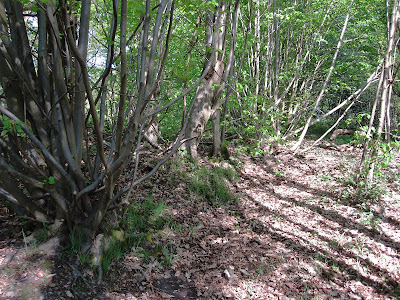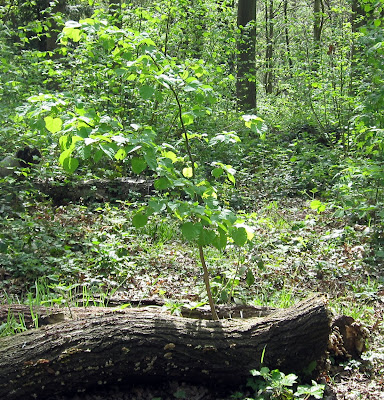 |
| Coppiced hazel, last cut 4 winters ago, and standard oaks in Spring Park. |
Spring Park is in two sections. The hillside section is wooded, 35 acres, and between the hill and the road are 15 acres of meadow. Both the woods and the meadow extend beyond the park into areas which are the responsibility of local councils. Some of the Council-managed areas are used for recreation, some are managed as natural areas. All, including Spring Park, are popular with the locals, particularly dog walkers.
 |
| Oak catkins in Spring Park. 22 April 2011. |
In the past, hazel would have been used for charcoal. The tall oaks scattered through the woods — 40 per acre — were also a crop, and would have been used in ship and house construction. They would have been harvested at about the size these are now, or a bit sooner.
Woodland management of this sort was neglected before 1987, but the hurricane-strength winds that blew down so many trees made it essential to do something; the woods were closed to the public all that winter until dangerous areas could be cleared. And it was decided then to re-start coppice management.
 |
| A bank and ditch at the border of Spring Park, with small-leaved limes. |
A number of other trees are scattered through the woods. There are some old yews, and some newer incomers like cherries, white beam, rowan and silver birch, which add pleasantly to the diversity of the area.
Small-leaved limes are well embedded here. This is a scarce tree (in nature) and a good sign of an ancient woodland. They need very warm summers to produce seeds, so seedlings are rare; Barry knows of only three in this wood. Luckily for the species, they are very good at producing suckers and will also regrow from the base if the original trunk dies back, rather like a natural coppice.
 |
| Seedling of a small-leaved lime in Spring Park. 22 April 2011 |
It runs down the hill at the border between Bromley and Croydon councils, probably at one time the border of Kent and Surrey. These trees were all pollards before 1987, but when some were blown down they were cut back and have regrown from ground level. Small-leaved limes were harvested for use in rope-making.
I saw many splendid flowers in the woods. There are thousands of bluebells just reaching their peak, as well as areas of lesser celandine and wood anemone, almost finished flowering. There was some herb Robert, and many yellow archangels, which like the bluebells are a good sign of an ancient woodland. These are spreading well in newly coppiced areas. Also flowering along the paths and at the margins were white dead-nettle, greater stitchwort, cow parsley, buttercups and dandelions. Among the trees, the oaks were covered with catkins, and there were masses of creamy flowers on the rowans.
 |
| Photograph of Spring Park and surroundings taken by the Luftwaffe in 1942. Click on it to see it enlarged. |
You can see a few dark dots bisecting the meadow top to bottom. That is the line of an old hedgerow, which the rangers plan to reinstate this coming winter, with a pleasant mix of hawthorns, blackthorns, hazel and spindle — all local hedgerow species.
As you can see, this was a very interesting and informative walk, and lots of questions were asked and answered. The City of London has a web page on Spring Park here: Spring Park.
 |
| Barry Gutteridge pointing out a pollarded small-leaved lime to the group. Spring Park, 22 April 2011. |
No comments:
Post a Comment